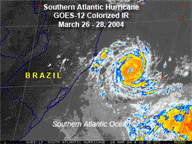Ah yes. We have finally stirred up a pretty good back and forth here. I just got back...no drinks...and found a couple of really good posts. I'll do my best to respond with my POV...
First...I'll try to crystalize my thoughs in the context of Mr southerlands well crafted post.
The first issue concerns value. Do such forecasts offer value?
I think that depends on who you ask. Is it fruitless? No...I believe that over time computer modeling and additional climatological data through technologies suck as QuikScat will make the science more accurate.
However...NOAA flipped out when landfall percentages were put up on Gray's experimental site. It will cause confusion and complacency...they say. Riiigght. This is just another attempt to hang on to their one voice approach now that the technology...once available only to them...is readily avaiable to everyone (well...almost all of it).
I believe forging ahead is also worthwhile...there will be good years and bad years...but I think it will be 15-20 years with the current technology to get a good read on the results as they are verified.
Here's a good example. Let's say that this year's forecast calls for a 30% chance of a landfall in SW florida. We need 10 analog years with conditions very close to this year to determine skill. Hindcasting takes care of some of this...but there are not enough reliable years in the dataset. In fact...we really only have a little more than 40 years in our dataset since satellites were used.
The second issue concerns verifiability. Are such forecasts verified?
They are...but my main point is how are they verified? Good results are one thing...but the baseline for this and any forecast like this has to be climatology...otherwise there is no context for evaluation. I believe JB would benefit from coming up with a scheme to verify these foreasts vs. climatology. There has to be a way to determine relative skill. I'm going to think about that and see if there is a way to do it. Climo can be universal...and absolute.
The third question that arose—and on the face of things, it’s a good one—concerns whether it is realistic for JB’s top designated landfall area to be adjacent to a below-average landfall area.
I'm going to have to concede that this does happen all the time. My hometown in Kansas always got about half the snowfall that Wichita got even though the cities were an hour away from each other. But I still don't believe we have the ability to give SW Fl a 1 and SE Fl a 7 on a 10 point scale...another Cleo could come right up the middle and verify and bust the same forecast.
A fourth question concerns what is foreseeable.
My bone of contention is that although some things...such as low pressures in the ITCZ or a stronger than average Azores high can be forseen...small butterflies in the Matrix make nailing down landfalls along the US coast difficult.
Again, great post donsoutherland.
Steve...I feel my previous reply was incomplete:
I read all your posts. I just disagreed wtih one point you had made which was that even if the landfall intensity forecast verifies 100%, it doesn't say anything. I disagree with that.
I agree with your disagreement. I left out a critical piece of that sentance that I though of but had to reread before I noticed I left it out:
(in a single year).
I don't think one year is significant. It is something to build on...and a suggestion that the forecaster is on the right track. But more data needed.
Perhaps hindcasting could help here too...and maybe JB has done that.
I never though you had any problem with me...I just didn't know if you knew that I verify my stuff the best I can...
Thanks to you and everyone else for adding to the discussion...I've enjoyed this one.
MW









